Porpoise Class: Difference between revisions
Pbcjohnston (talk | contribs) mNo edit summary |
Pbcjohnston (talk | contribs) (→Design and Construction Notes: Updated visual guide link) |
||
| (3 intermediate revisions by the same user not shown) | |||
| Line 2: | Line 2: | ||
=== <big>Design and Construction Notes</big> === | === <big>Design and Construction Notes</big> === | ||
<div style="text-align: justify;"><span style="color:#00008B">By 1933 the Navy had learned a lot from the largely experimental V-class fleet submarines. That experience led the Navy to design the Porpoise class of fleet submarines, a refinement of the earlier [[Dolphin|'''Dolphin''']] and [[Cachalot and Cuttlefish|'''Cachalot''']]. The National Industrial Recovery Act of 1933 provided needed money to spur shipbuilding in the U.S. and the Navy took advantage by ordering four submarines for Fiscal Year 1934. Now with firm reins on the submarine acquisition process, the Navy ordered two of these boats (Porpoise & Pike) to be built at the Portsmouth Navy Yard in Kittery, ME., and two (Shark & Tarpon) from the revitalized Electric Boat Company (EB) of Groton, CT. The Navy allowed EB to build its two boats to a divergent, but similar design that used a welded partial double hull. Portsmouth, still not convinced of the efficacy of welding, built its two boats to a traditional riveted full double hull design. All four boats had the same armament, engineering plants, and performance so they were considered to be in the same class despite the different hull form. FY-35 appropriations approved funds for six more boats, | <div style="text-align: justify;"><span style="color:#00008B">By 1933 the Navy had learned a lot from the largely experimental V-class fleet submarines. That experience led the Navy to design the Porpoise class of fleet submarines, a refinement of the earlier [[Dolphin|'''Dolphin''']] and [[Cachalot and Cuttlefish|'''Cachalot''']]. The National Industrial Recovery Act of 1933 provided needed money to spur shipbuilding in the U.S. and the Navy took advantage by ordering four submarines for Fiscal Year 1934. Now with firm reins on the submarine acquisition process, the Navy ordered two of these boats (Porpoise & Pike) to be built at the Portsmouth Navy Yard in Kittery, ME., and two (Shark & Tarpon) from the revitalized Electric Boat Company (EB) of Groton, CT. The Navy allowed EB to build its two boats to a divergent, but similar design that used a welded partial double hull. Portsmouth, still not convinced of the efficacy of welding, built its two boats to a traditional riveted full double hull design. All four boats had the same armament, engineering plants, and performance so they were considered to be in the same class despite the different hull form. FY-35 appropriations approved funds for six more boats, and the Navy decided to standardize on the EB style partial double hull for all six. | ||
The Perch group consisted of two boats built at Portsmouth, one at Mare Island, and three built by EB. The three Navy yard boats were the last riveted submarines for the Navy, while the EB boats were fully welded. The ten boats of the Porpoise class also set a new precedent: they were the first USN submarines to have all-electric drive. All previous submarines were equipped with direct drive diesel engines. For the Porpoise class the engines drove only generators and were not connected directly to the propeller shafts. The electricity they generated drove motors attached to the shafts or recharged the massive storage batteries. | The Perch group consisted of two boats built at Portsmouth, one at Mare Island, and three built by EB. The three Navy yard boats were the last riveted submarines for the Navy, while the EB boats were fully welded. The ten boats of the Porpoise class also set a new precedent: they were the first USN submarines to have all-electric drive. All previous submarines were equipped with direct drive diesel engines. For the Porpoise class the engines drove only generators and were not connected directly to the propeller shafts. The electricity they generated drove motors attached to the shafts or recharged the massive storage batteries. | ||
Most of the boats received modifications and modernizations during the war. Their fairwaters were cut down to lessen the overall silhouette, and they received additional or upgraded gun armament, radar, and other improvements. During overhauls in 1942 Porpoise, Pike, Tarpon, Pickerel, and Permit were fitted with two additional external forward firing torpedo tubes in the superstructure just below the main deck forward of the bow planes. This was a belated attempt at increasing firepower, but the experiment was not successful. | |||
These boats were in the thick of the fight against the Japanese from the first day of the war. Four of them (marked by a *) and their brave crews were lost in action and are considered to be "on eternal patrol". | These boats were in the thick of the fight against the Japanese from the first day of the war. Four of them (marked by a *) and their brave crews were lost in action and are considered to be "on eternal patrol". | ||
'''Note'''... many early photos of these boats will show them with large "P" class identifiers painted on their bows and fairwaters. These were used to identify the boats visually while on the surface. They were NOT their names or designations. The use of these identifiers was common on the fleet boats but faded out in favor of hull numbers in | '''Note'''... many early photos of these boats will show them with large "P" class identifiers painted on their bows and fairwaters. These were used to identify the boats visually while on the surface. They were NOT their names or designations. The use of these identifiers was common on the fleet boats but faded out in favor of hull numbers in 1939 because their use became confusing. | ||
There were a lot of variations in the external appearance of these boats over the years. For a thorough explanation of these changes, please take a few minutes to read [ | There were a lot of variations in the external appearance of these boats over the years. For a thorough explanation of these changes, please take a few minutes to read [https://pigboats.com/images/e/e4/A_VISUAL_GUIDE_TO_THE_FLEET_SUBMARINES_PART_2_Porpoise_Class_2023.pdf '''this article'''].</span></div> | ||
[[File:Red bar sub new 2.jpg]] | [[File:Red bar sub new 2.jpg]] | ||
Latest revision as of 18:12, 11 May 2024
Design and Construction Notes
The Perch group consisted of two boats built at Portsmouth, one at Mare Island, and three built by EB. The three Navy yard boats were the last riveted submarines for the Navy, while the EB boats were fully welded. The ten boats of the Porpoise class also set a new precedent: they were the first USN submarines to have all-electric drive. All previous submarines were equipped with direct drive diesel engines. For the Porpoise class the engines drove only generators and were not connected directly to the propeller shafts. The electricity they generated drove motors attached to the shafts or recharged the massive storage batteries.
Most of the boats received modifications and modernizations during the war. Their fairwaters were cut down to lessen the overall silhouette, and they received additional or upgraded gun armament, radar, and other improvements. During overhauls in 1942 Porpoise, Pike, Tarpon, Pickerel, and Permit were fitted with two additional external forward firing torpedo tubes in the superstructure just below the main deck forward of the bow planes. This was a belated attempt at increasing firepower, but the experiment was not successful.
These boats were in the thick of the fight against the Japanese from the first day of the war. Four of them (marked by a *) and their brave crews were lost in action and are considered to be "on eternal patrol".
Note... many early photos of these boats will show them with large "P" class identifiers painted on their bows and fairwaters. These were used to identify the boats visually while on the surface. They were NOT their names or designations. The use of these identifiers was common on the fleet boats but faded out in favor of hull numbers in 1939 because their use became confusing.
There were a lot of variations in the external appearance of these boats over the years. For a thorough explanation of these changes, please take a few minutes to read this article.Porpoise (SS-172)
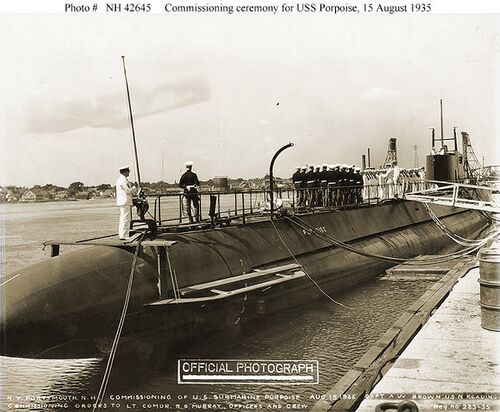
Pike (SS-173)
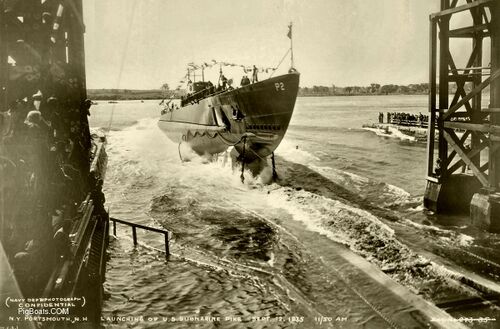
Shark (SS-174)*
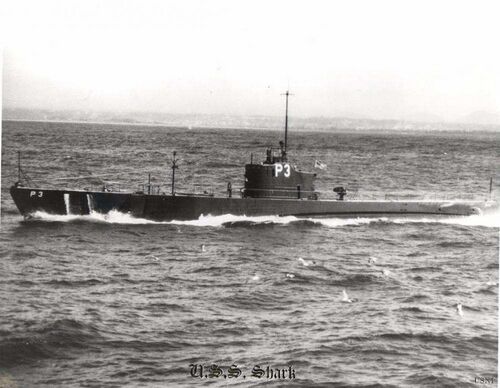
Tarpon (SS-175)
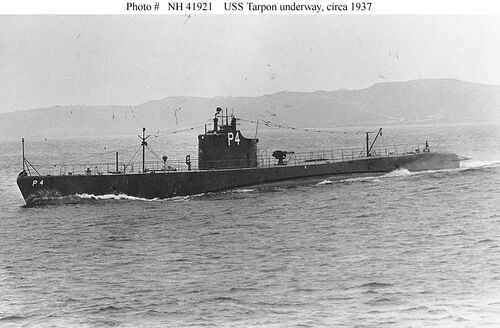
Perch (SS-176)*
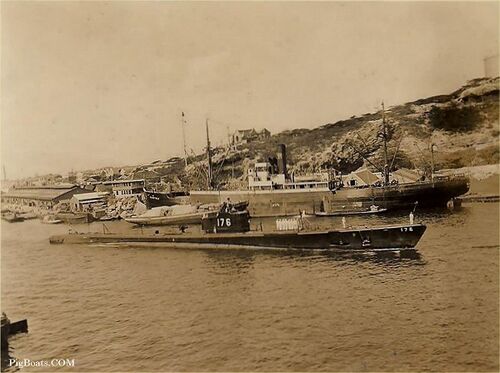
Pickerel (SS-177)*
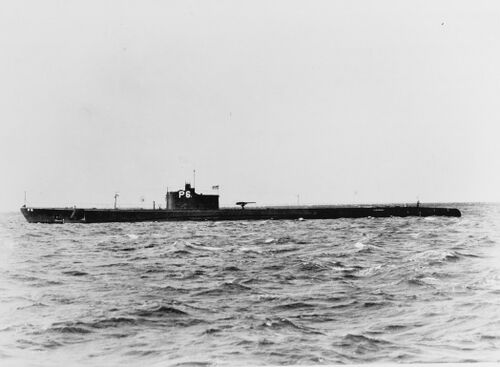
Permit (SS-178)
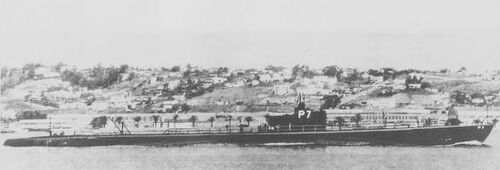
Plunger (SS-179)
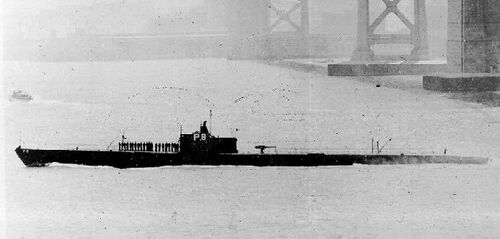
Pollack (SS-180)

Pompano (SS-181)*
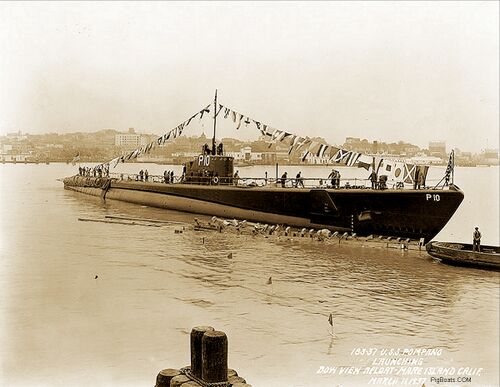
General Porpoise Class photos
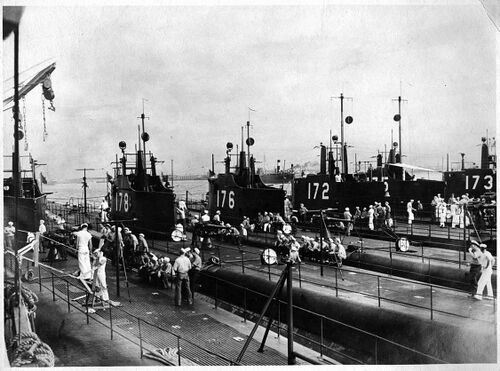
See more general Porpoise Class photos
Page created by:
Ric Hedman & David Johnston
1999 - 2023 - PigBoats.COM©
Mountlake Terrace, WA, Norfolk, VA
webmaster at pigboats dot com
